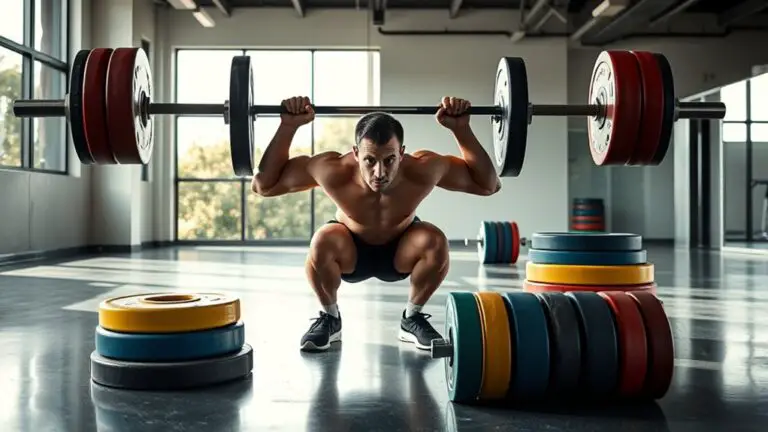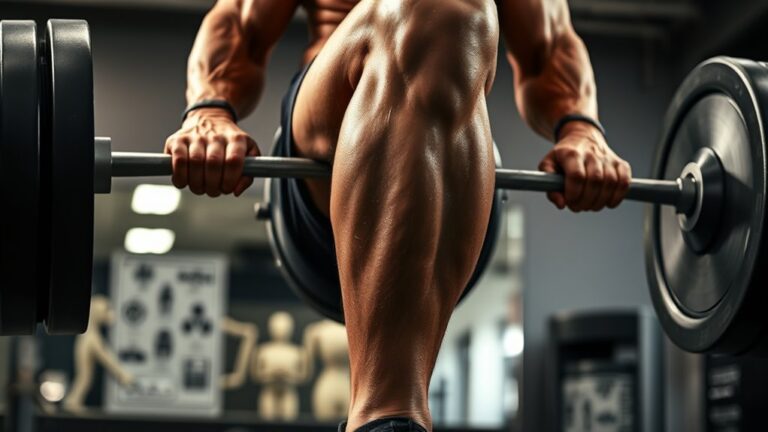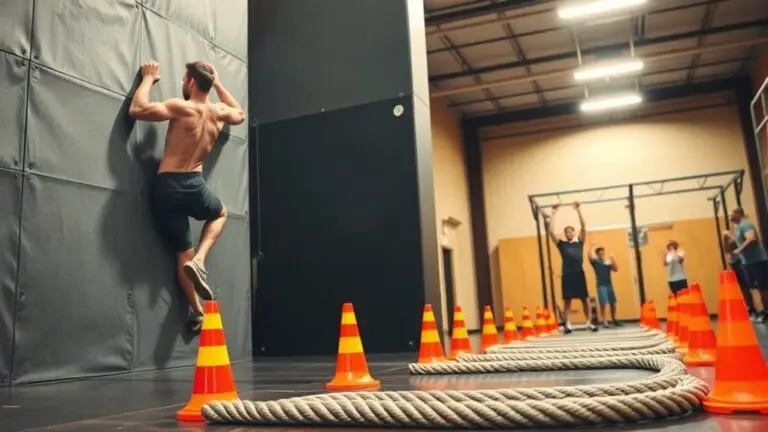Best Mobility Exercises for Older Gym-Goers
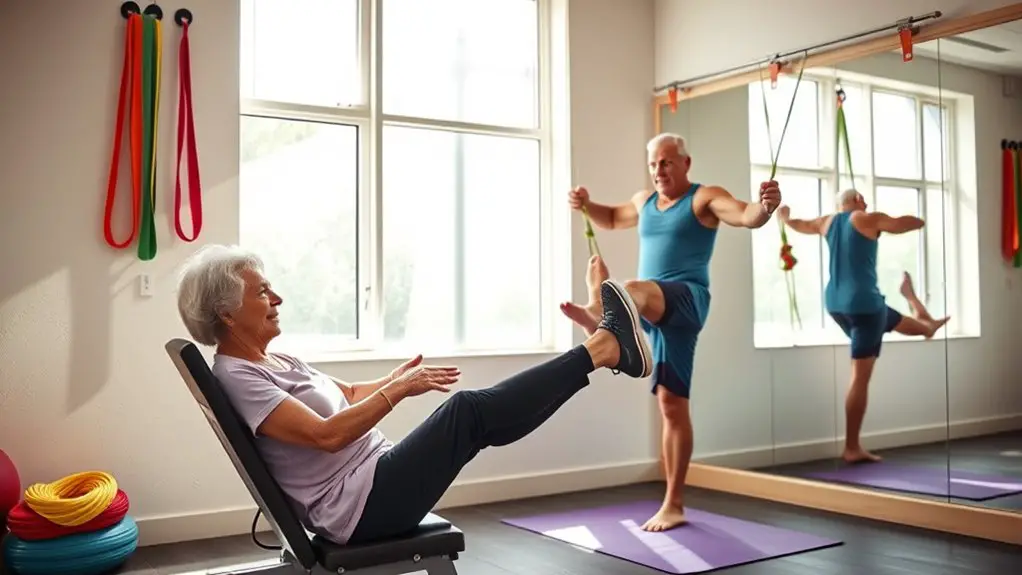
As an older gym-goer, maintaining your mobility’s key for your health and independence. Dynamic stretching techniques, like standing leg swings and seated torso twists, can improve flexibility and balance. Don’t forget ankle mobility exercises for stability! Try ankle circles, calf stretches, and toe raises to keep your ankles strong. Prioritizing these exercises enhances your quality of life and enjoyment in activities. There’s even more valuable information ahead to help you stay active and mobile.
Importance of Mobility for Older Adults
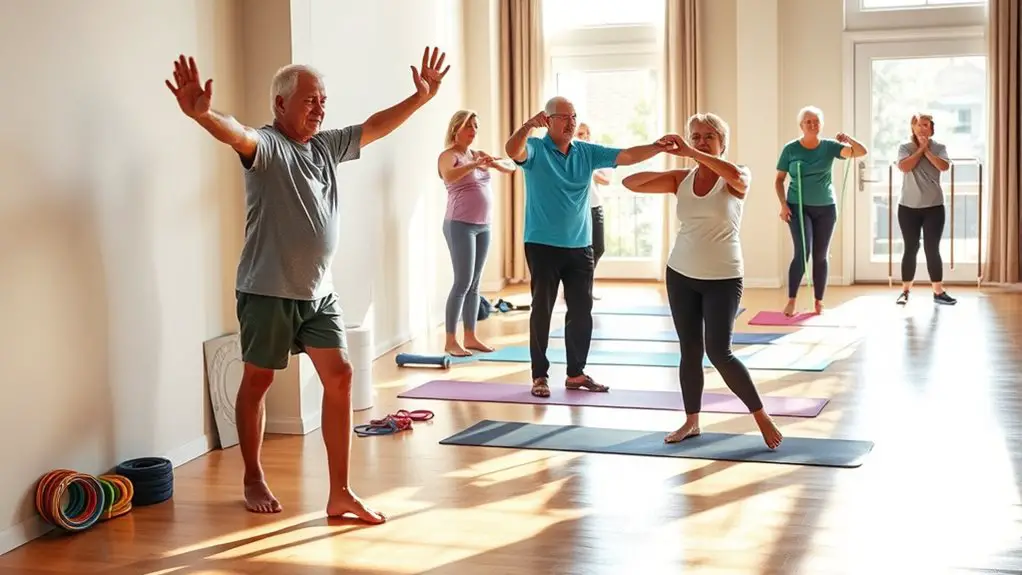
As you age, maintaining mobility becomes essential for your overall health and independence. Keeping your joints flexible is critical for performing everyday tasks safely, from bending down to tie your shoes to reaching for items on high shelves. Improved joint flexibility also helps prevent injuries, enabling you to stay active longer.
Balance improvement is another important aspect of mobility. As you work on your balance, you’ll reduce the risk of falls, which can lead to serious injuries. Simple exercises can enhance your stability, allowing you to navigate your environment with confidence.
Incorporating mobility exercises into your routine not only helps maintain joint flexibility but also supports overall well-being. You’ll find that moving more freely leads to a better quality of life, enabling you to enjoy activities you love without the fear of losing your independence. Prioritizing these exercises is a proactive step toward healthier aging.
Dynamic Stretching Techniques
To enhance your mobility and support joint flexibility, incorporating dynamic stretching techniques into your routine can be highly beneficial. Dynamic warm-ups, unlike static stretches, involve active movements that prepare your muscles and joints for exercise. They help increase blood flow, improve coordination, and reduce the risk of injury.
Start with gentle movements, like arm circles and leg swings, to guarantee you’re comfortable. Focus on larger muscle groups and gradually increase your range of motion. As you perform these flexibility routines, pay attention to your body’s signals—never push through pain.
Incorporating these techniques not only boosts your mobility but also enhances your overall workout experience. Aim for 5-10 minutes of dynamic stretching before your main exercise session to get your body ready. By prioritizing safety and listening to your body, you’ll set a solid foundation for effective and enjoyable workouts.
Standing Leg Swings

Standing leg swings are an excellent dynamic stretching exercise that can greatly enhance your hip mobility and overall lower body flexibility. This exercise not only promotes flexibility enhancement but also aids in balance improvement, making it perfect for older gym-goers.
To perform standing leg swings safely, follow these steps:
- Stand tall: Use a wall or sturdy object for support if needed.
- Swing your leg: Gradually swing one leg forward and backward, maintaining control.
- Keep your core engaged: This helps improve balance and stability during the movement.
- Switch legs: After 10-15 swings, switch to the other leg and repeat.
Seated Torso Twists
Seated torso twists are a fantastic way to improve spinal mobility and flexibility, especially for older gym-goers. This exercise can be performed in various seated variations, making it accessible for everyone. To start, sit up straight in a sturdy chair with your feet flat on the ground. Place your hands gently on your knees or the chair’s armrests. As you inhale, lengthen your spine; on the exhale, slowly twist your torso to one side, holding for a moment before returning to center. Repeat on the other side.
Focusing on your breath during this movement enhances core stability, which is essential for maintaining balance and preventing injury. Always listen to your body—if you feel any discomfort, ease up on your twist. This gentle exercise helps increase flexibility, promotes better posture, and can be a safe addition to your routine, supporting overall mobility as you age.
Cat-Cow Stretch
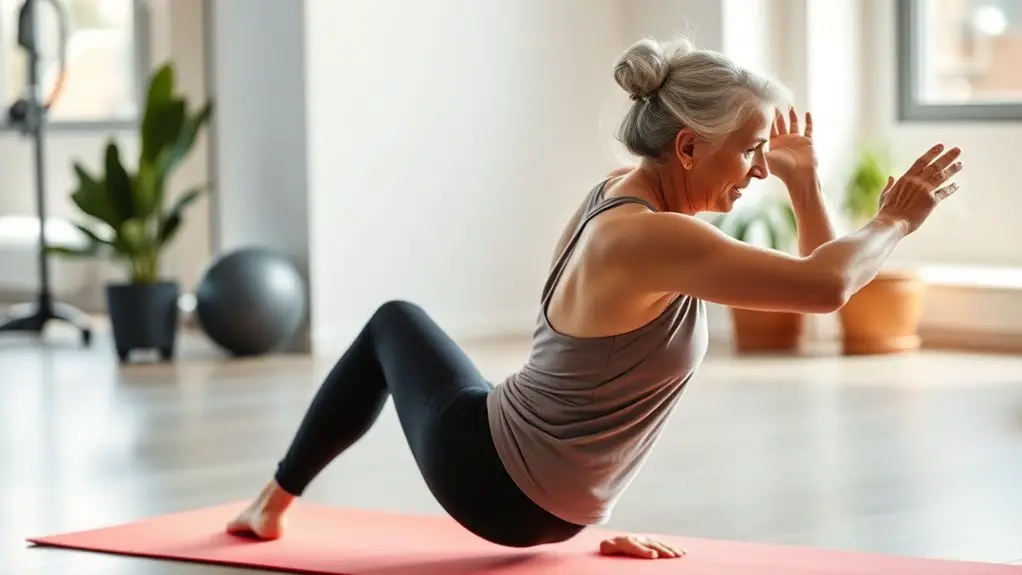
After incorporating seated torso twists into your routine, the Cat-Cow stretch is another excellent way to enhance spinal mobility and flexibility. This gentle movement can provide significant cat cow benefits, such as improved posture and reduced back tension. Here’s how to perform it with proper form:
- Start on your hands and knees in a tabletop position.
- Inhale as you arch your back, dropping your belly towards the floor (Cow position).
- Exhale while rounding your spine, tucking your chin to your chest (Cat position).
- Repeat this sequence for 5-10 breaths, focusing on smooth changes.
Always listen to your body, adjusting the range of motion to what feels comfortable. If you experience any discomfort, stop and consult a fitness professional. Regularly practicing the Cat-Cow stretch can help keep your spine mobile and promote overall well-being as you age.
Hip Openers
Since maintaining hip mobility is essential for overall movement and balance, incorporating hip openers into your routine can be incredibly beneficial. These exercises improve hip flexibility and promote joint health, helping you move with greater ease.
Start with gentle stretches like the seated butterfly stretch, where you sit with the soles of your feet together and gently press your knees toward the floor. This promotes hip flexibility and reduces tightness. Another effective option is the figure-four stretch, which can be done while lying on your back or seated.
Always listen to your body and avoid pushing yourself too hard. If you feel any discomfort, ease back or adjust the stretch. Aim to hold each position for 20-30 seconds, breathing deeply to encourage relaxation. Incorporating these hip openers regularly can enhance your mobility, making daily activities safer and more enjoyable.
Ankle Mobility Exercises
To enhance your overall stability and movement, incorporating ankle mobility exercises into your routine is essential. Good ankle mobility can prevent injuries and improve your balance, especially as you age. Here are four simple exercises you can try safely:
Incorporating ankle mobility exercises is crucial for enhancing stability, preventing injuries, and improving balance as you age.
- Ankle Circles: While seated, lift one foot off the ground and rotate your ankle in circular motions—10 times clockwise and 10 times counterclockwise.
- Calf Stretches: Stand facing a wall, place your hands on it, and step one foot back. Keep your back leg straight and heel on the ground. Hold for 15-30 seconds, then switch legs.
- Toe Raises: Stand tall and slowly rise onto your toes. Hold for a few seconds and lower back down. Repeat 10-15 times.
- Heel Walks: Walk on your heels for 10-20 steps to engage your ankles and strengthen your calves.
These exercises are easy to integrate and can greatly improve your mobility!
Frequently Asked Questions
How Often Should Older Adults Perform Mobility Exercises?
When it comes to how often you should perform mobility exercises, frequency guidelines suggest aiming for at least two to three times a week. Each session shouldn’t take too long; about 20 to 30 minutes is ideal. This helps improve your flexibility and balance without putting too much strain on your body. Remember, consistency is key, and it’s always wise to listen to your body and adjust as needed for your safety.
Are There Any Risks Associated With Mobility Exercises?
Yes, there are risks associated with mobility exercises, especially if they’re not done correctly. It’s essential to conduct a benefit assessment before starting any routine. You should listen to your body and avoid pushing too hard, as this can lead to injury. Focusing on proper form and gradually increasing intensity can help with injury prevention. Always consult a healthcare professional if you’re unsure, to guarantee your safety and well-being during exercises.
Can Mobility Exercises Help With Arthritis Pain?
Imagine a tree in winter, its branches stiff and bare. Just like that tree, your joints can feel rigid with arthritis. But through gentle mobility exercises, you can nurture your joint flexibility, allowing your body to thrive again. These movements can be an essential part of your arthritis management, easing pain and promoting comfort. With patience and care, you can help your body bloom, welcoming a more active and vibrant life.
What Equipment Is Needed for Mobility Exercises?
When you’re diving into mobility exercises, having the right equipment can make a big difference. You’ll find yoga blocks useful for support and stability during stretches, helping you maintain proper form. Resistance bands are also great; they add gentle resistance to your movements, making exercises more effective without risking injury. Remember, it’s important to listen to your body and choose equipment that feels safe and comfortable for you.
Should Older Adults Consult a Doctor Before Starting?
Absolutely, you should consult a doctor before diving into any new exercise routine—it’s like asking a chef for the secret ingredient to a delicious dish! Doctor recommendations and health assessments can reveal hidden treasures about your well-being. Don’t skip this step; it guarantees you’re on the right track and reduces risks. So, before you roll out that yoga mat or hit the gym, get that green light from your doc—your future self will thank you!
